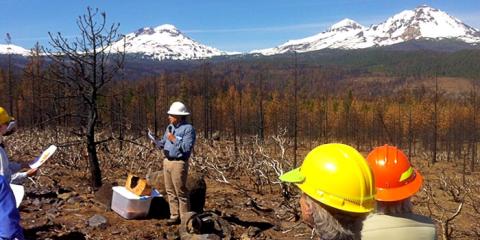Pole Creek Fire – One Year Later
June 25, 2013
In early June, I attended a community field tour of the nearly year-old Pole Creek Fire in the Deschutes National Forest outside the town of Sisters in central Oregon.
Lightning caused this fire, which erupted Sept. 8, 2012, and burned about 26,000 acres, or about 40 square miles. According to The Bulletin newspaper, “the fire destroyed four cars at the trailhead, a popular gateway to the Three Sisters Wilderness, prompted about 30 hikers and campers to find a different route out of the forest. Later, it walloped Sisters with waves of morning smoke deemed hazardous to health. The fire cost about $18 million to fight.”
Organizers held two five-hour tours, one on a Friday, and the other on a Saturday. About 50 people attended each day, cramming a bright yellow school bus.
Before we boarded, the leaders asked us to choose five words that describe the impact of forest fire on us as individuals. Most of the people were from central Oregon. Most used words like “smoke,” “air quality” and “health issues” to describe the fire’s impact.
During the tour, we learned about fire ecology and how a century of fire suppression has created dense forests that are over-stocked with an understory of small-diameter trees. In the past, periodic, low-intensity fires removed this understory, leaving the larger and more resilient trees – mainly ponderosa pine – to grow even larger. But with fire suppression and little harvest, the understory creates what is called a “fuel ladder” that allows fire to climb into the crowns of the larger trees, killing them.
Not all trees died. The U.S. Forest Service estimates that about 24 percent of the 26,119 fire acres were lightly to moderately burned and will recover. This occurred mainly where forest management thinning had already cleared much of the understory. About 36 percent of the acreage experienced mixed mortality. The remaining 40 percent, however, was destroyed – what foresters call “stand replacing.”
Some salvage is taking place. The Forest Service plans to remove trees that pose a danger to people and traffic along about 40 miles of forest roads. It also is planning to salvage log about 1,000 acres in an area that experienced stand-replacing fire. Per the Forest Service’s protocol, a number of large snags will be left on harvested sites for wildlife habitat.
At the conclusion of the tour, Pete Caligiuri, who works for The Nature Conservancy in Central Oregon, discussed the Deschutes Collaborative Forest Project. Pete told the group that the collaborative is a community-based organization that is advising the Forest Service on restoration activity in the Deschutes National Forest. One goal of the project is to identify areas that are the most departed from historic conditions, then treat them before wildfire occurs through thinning, selective harvest and prescribed burning. This will create healthier, more fire-resilient forests
Pete and the collaborative hope that by restoring forest health and fire resiliency, they can prevent intense fires such as the Pole Creek Fire from occurring in the future.
For the Forest,
Paul Barnum
Executive Director
Photo: With the peaks of the Three Sisters and the Deschutes National Forest burned during the 2012 Pole Creek Fire as a backdrop, Dr. Steve Fitzgerald, OSU professor and area extension forester for the central Oregon region, provided an overview of east Cascades forest ecology, the role of fire and current forest conditions.
